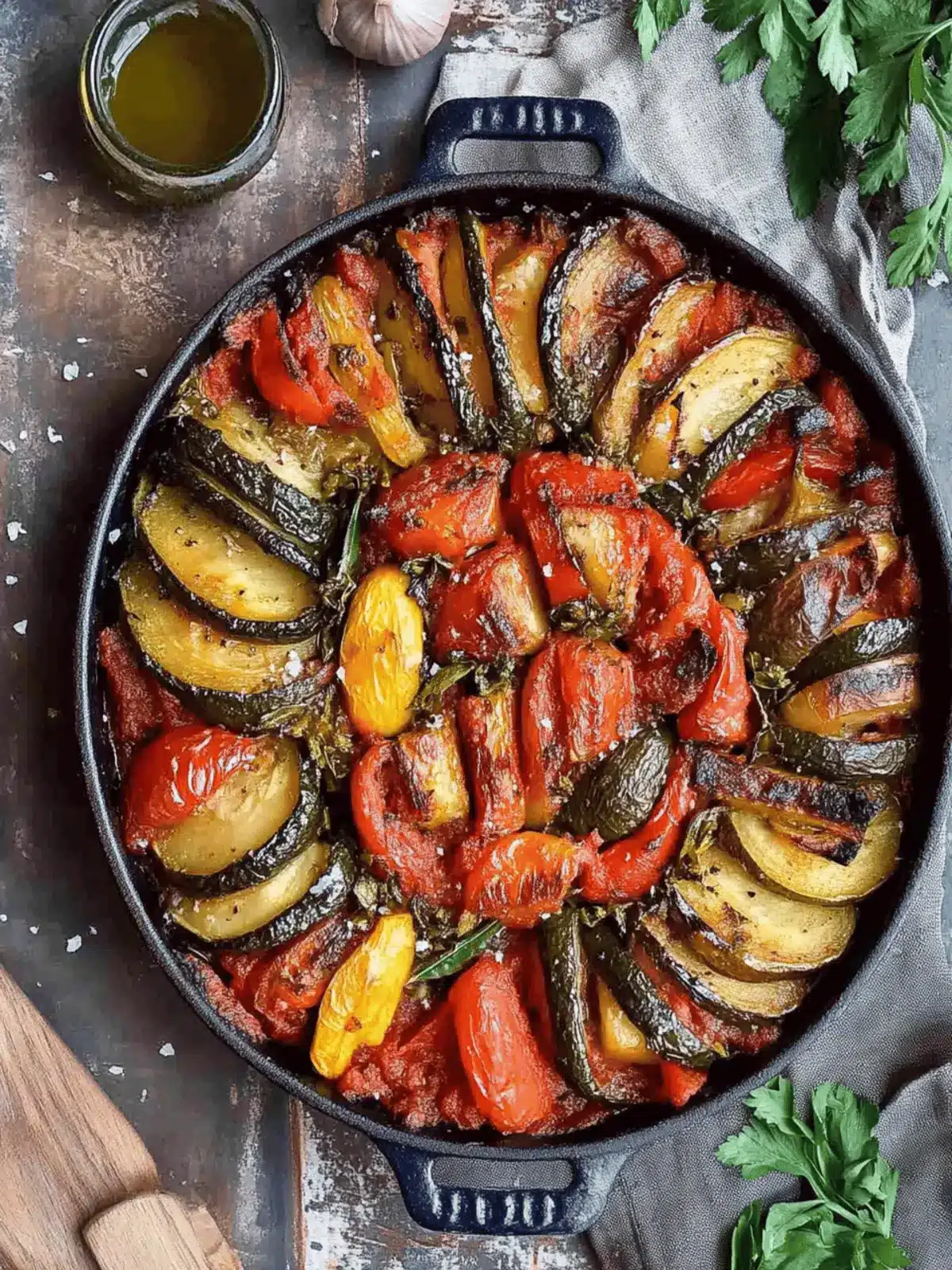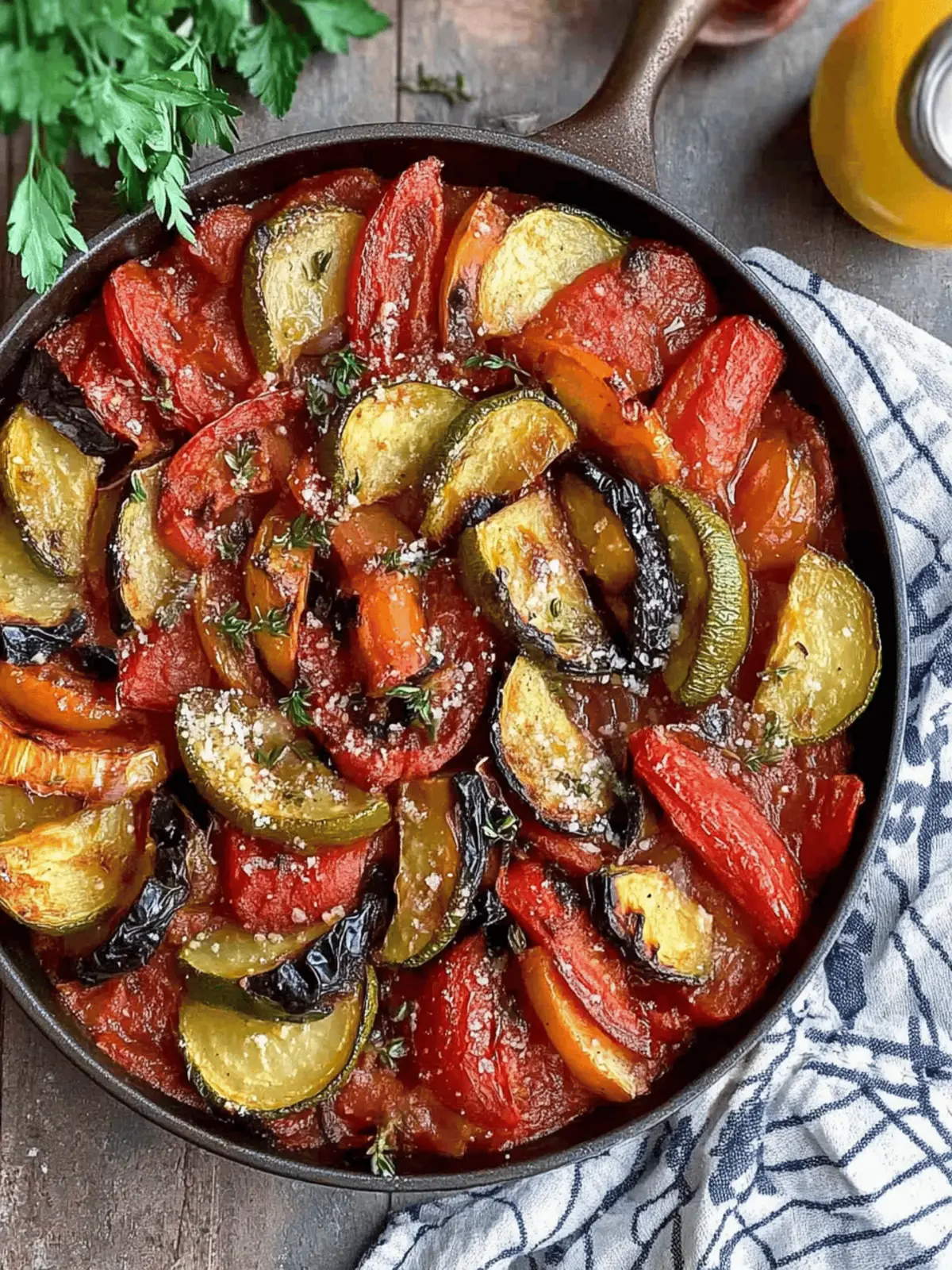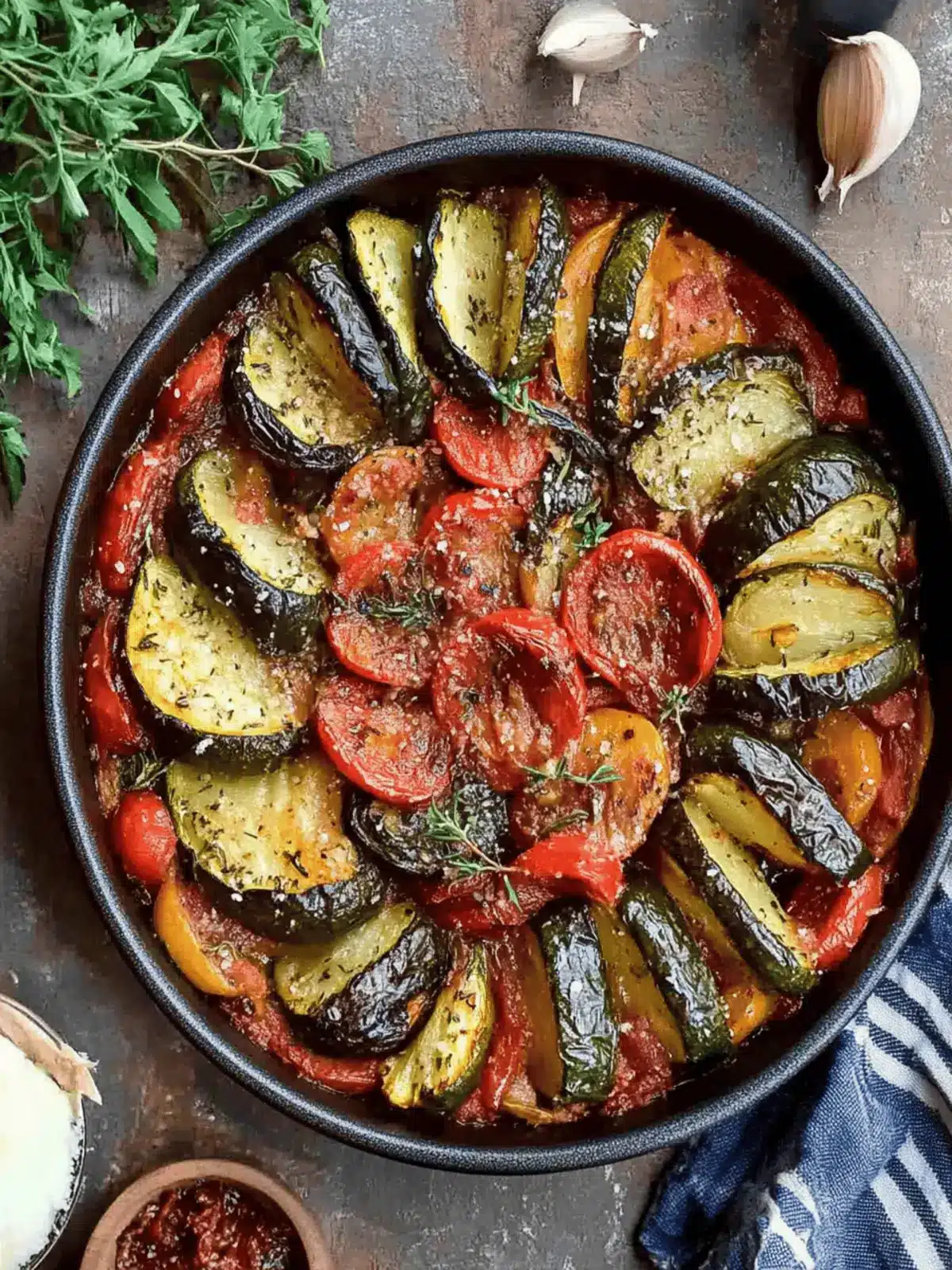There’s something extraordinary about the way simple ingredients transform into a colorful feast when roasted just right, especially in the Mediterranean kitchen. The scent of garlic mingling with fresh oregano fills the air as you prepare to slice vibrant potatoes, zucchini, and juicy tomatoes. This traditional Greek Briam, or roasted vegetables, showcases the incredible flavors of wholesome, seasonal produce, seamlessly turning your kitchen into a rustic taverna.
Whether you’re looking to jazz up your dinner routine or impress guests with a healthy yet hearty dish, this vegan and gluten-free recipe is your answer. With minimal effort, you can create a stunning centerpiece that not only celebrates the magic of vegetables but also caters to various dietary needs, making it perfect for everyone around the table. So grab your knife and get ready to enjoy an authentic taste of Greece, where every bite of roasted goodness captivates your senses!
Why is Traditional Greek Roasted Vegetables irresistible?
Irresistible Flavors: Each ingredient melds together to create a symphony of robust Mediterranean flavors that dance on your palate.
Ease of Preparation: This recipe simplifies cooking with minimal prep and effortless assembly, making it perfect for busy weeknights.
Versatile Dish: Enjoy Greek Briam as a satisfying main or a vibrant side alongside grilled meats or grains, accommodating various dietary preferences like Keto or vegan diets.
Batch Cooking Friendly: Make ahead and enjoy leftovers throughout the week without losing flavor or texture—great for meal prep enthusiasts!
A Crowd-Pleaser: With its colorful presentation and tantalizing aroma, this dish is sure to impress guests at any gathering, ensuring everyone leaves raving about the meal.
Traditional Greek Roasted Vegetables Ingredients
• Dive into the vibrant world of Traditional Greek Roasted Vegetables with these simple yet essential ingredients!
For the Base
- Potatoes – Essential for heartiness; Yukon Gold or Russet give a creamy texture.
- Zucchini – Adds moisture and a tender bite; yellow squash works as a lovely substitute.
- Red Onions – Bring sweetness and depth; yellow onions can easily step in when needed.
- Tomatoes (canned diced) – Create a rich, saucy base for roasting; fresh tomatoes are a fantastic alternative.
For Flavoring
- Garlic – The aromatic superstar; fresh is best for that truly vibrant flavor.
- Parsley – Infuses freshness and brightens up the dish; basil makes a delightful swap.
- Extra Virgin Olive Oil (EVOO) – Provides essential richness; opt for high-quality Early Harvest EVOO for extra flavor.
- Oregano – Adds that classic Mediterranean touch; both fresh and dried are equally suited.
- Rosemary (optional) – Layers on a piney note; thyme can be a lovely alternative or simply omit.
Seasoning Essentials
- Salt and Pepper – The basics of seasoning; adjust to your taste for the perfect balance.
Unleash your inner chef by gathering these ingredients, and get ready to transform them into a luscious dish that will leave everyone asking for seconds!
How to Make Traditional Greek Roasted Vegetables
-
Prep Vegetables: Begin by thinly slicing the potatoes, zucchini, and red onions. This ensures even cooking and gets all those flavors mingling beautifully as they roast.
-
Mix Flavor Base: In a large bowl, toss the sliced vegetables with salt, pepper, extra virgin olive oil, garlic, and oregano until they are well coated. You want them to gleam with that delicious oil!
-
Assemble in Pan: Pour the diced tomatoes into an oven-safe pan. Arrange the seasoned vegetables in concentric circles or just spread them evenly atop the tomatoes to create a stunning rainbow of colors.
-
Drizzle Remaining Oil: Pour the leftover olive oil mixture over the beautifully arranged vegetables, followed by a sprinkle of additional diced tomatoes for even more flavor and moisture.
-
Cover and Roast: Cover the pan with aluminum foil, tenting it above the veggies to keep the steam in as they bake. Roast at 400°F (200°C) for about 40 minutes until they are tender and fragrant.
-
Final Touch: Once tender, uncover the pan and roast for an additional 10-15 minutes to let the veggies char slightly and enhance their natural sweetness. You may also place it under the broiler briefly for that extra golden touch!
Optional: Garnish with fresh parsley or crumbled feta for an added pop of flavor.
Exact quantities are listed in the recipe card below.
How to Store and Freeze Traditional Greek Roasted Vegetables
Fridge: Store leftover Greek Briam in an airtight container for up to 3 days. This keeps the flavors fresh and prevents moisture loss.
Freezer: For longer storage, freeze the roasted vegetables in a freezer-safe container for up to 3 months. Make sure to cool them completely before sealing to avoid ice crystals.
Reheating: When ready to enjoy, gently reheat in the oven at 350°F (175°C) for 15-20 minutes or until warmed through. You can add a splash of water to maintain moisture.
Room Temperature: Generally best enjoyed warm, avoid leaving out for more than 2 hours to ensure food safety.
What to Serve with Traditional Greek Roasted Vegetables?
Create a beautiful balance of flavors and textures with these delightful pairings that will elevate your meal.
-
Crusty Bread: The perfect companion for scooping up that rich, hearty sauce left by the roasted vegetables; a must-have for sopping up every last drop!
-
Quinoa Salad: A refreshing mix of quinoa, cucumber, and feta brings a cool crunch and added protein, enhancing the hearty dish beautifully.
-
Grilled Chicken: Complement the earthiness of Briam with juicy grilled chicken, marinated in lemon and herbs for a flavorful protein addition.
-
Tzatziki Sauce: The cool creaminess of tzatziki, made from yogurt and cucumber, contrasts brilliantly with the warm, roasted veggies and adds a lovely hint of tang.
-
Olives: A variety of Mediterranean olives introduces briny depth, perfectly balancing the sweetness from the roasted tomatoes and onions.
-
Feta Cheese: Crumbled feta adds a salty, creamy element that enhances the overall dish, making each bite incredibly satisfying and full of flavor.
-
Lemon Wedges: A squeeze of fresh lemon juice brightens every element on your plate; enhance the flavors of the Greek Briam and other side dishes.
-
Red Wine: Pair with a glass of refreshing Greek red wine; its fruitiness and mild tannins harmonize well with the rich flavors of the roasted vegetables.
Each option brings its unique flair, ensuring your meal is a delightful celebration of Mediterranean goodness.
Make Ahead Options
These Traditional Greek Roasted Vegetables are perfect for meal prep enthusiasts! You can slice the vegetables and toss them with the olive oil and spices up to 24 hours in advance, storing them in the refrigerator to save time during busy weeknights. The diced tomatoes can also be prepared ahead; just keep them in a covered container in the fridge for up to 3 days. When you’re ready to serve, simply arrange the marinated vegetables over the tomatoes, cover with foil, and roast as directed. This way, you’ll enjoy the same mouthwatering flavors and textures, making dinner effortless and delightful!
Expert Tips for Traditional Greek Roasted Vegetables
-
Uniform Cutting: Ensure all vegetables are sliced uniformly to promote even roasting, preventing some pieces from burning while others are undercooked.
-
Quality Ingredients: Invest in high-quality extra virgin olive oil; it enhances flavor and gives your Greek Briam a delicious richness that elevates the dish.
-
Proper Foil Tenting: Tent the foil when covering the dish to allow steam to circulate, helping to retain moisture without the foil touching the vegetables directly.
-
Flavor Boosting: For an extra depth of flavor, consider adding a splash of balsamic vinegar or a sprinkle of smoked paprika to the vegetable mixture before roasting.
-
Storage Savvy: Leftover Greek Briam can be stored in the fridge for up to 3 days. Reheat gently to preserve the texture and flavor—avoid microwaving for the best results.
Traditional Greek Roasted Vegetables Variations
Feel free to explore and tailor this dish to your taste preferences or dietary needs!
- Keto-Friendly: Omit potatoes for a lower-carb version, relying on zucchini and onions instead for heartiness.
- Add Eggplant: Include sliced eggplant for a lovely, creamy texture and additional Mediterranean flair.
- Bell Peppers: Toss in colorful bell peppers, which add sweetness and crunch to your veggie medley.
- Herb Boost: Mix fresh dill with the parsley for an unexpected burst of vibrant flavor.
- Spice It Up: Introduce a pinch of red pepper flakes for gentle heat, giving the dish a delightful kick.
- Cauliflower: Swap out one of the vegetables for cauliflower, offering a unique flavor and satisfying texture.
- Tomato Variation: Use roasted cherry tomatoes instead of diced for a burst of sweetness in every bite.
- Olive Variety: Experiment with Kalamata olives to add a briny twist that complements the vegetables beautifully.
These variations make it easy to enjoy Greek Briam in a way that’s uniquely yours!
Traditional Greek Roasted Vegetables Recipe FAQs
What vegetables are best for Greek Briam?
Absolutely! The classic vegetables used in Greek Briam include potatoes, zucchini, red onions, and tomatoes. Potatoes serve as the hearty base, while zucchini adds moisture. Feel free to incorporate other veggies such as eggplant or bell peppers for extra flavor!
How should I store leftover Greek Briam?
You can store leftover Greek Briam in an airtight container in the refrigerator for up to 3 days. Just make sure it has cooled down to room temperature before sealing the container—this helps maintain freshness and prevent moisture loss.
Can I freeze Greek Briam?
Yes! To freeze Greek Briam, allow it to cool completely, then transfer it into a freezer-safe container. It can be kept in the freezer for up to 3 months. When you’re ready to enjoy, reheat in the oven at 350°F (175°C) for about 15-20 minutes. Adding a splash of water can help keep the dish moist.
What if my roasted vegetables are soggy?
Very! If you find your vegetables are soggy, ensure you’re cutting them uniformly and not overcrowding the roasting pan. Make sure to tent the foil to allow steam to circulate without touching the veggies, which helps to maintain their texture. Roasting at a higher temperature also contributes to a caramelized finish.
Are there any dietary considerations for Greek Briam?
Certainly! This recipe is vegan, gluten-free, and fits perfectly into the Mediterranean diet, making it suitable for a wide range of dietary preferences. Always double-check ingredients used, such as ensuring any stock or extra flavorings are gluten-free if that’s a concern.
How do I make Greek Briam Keto-friendly?
You can easily modify Greek Briam to fit a Keto diet! Simply omit the potatoes, which are higher in carbs, and load up on low-carb vegetables like zucchini, bell peppers, and cauliflower. This allows you to enjoy a flavorful dish while staying within your carbohydrate limits.

Savory Traditional Greek Roasted Vegetables That Wow!
Ingredients
Equipment
Method
- Prep Vegetables: Begin by thinly slicing the potatoes, zucchini, and red onions.
- Mix Flavor Base: In a large bowl, toss the sliced vegetables with salt, pepper, olive oil, garlic, and oregano.
- Assemble in Pan: Pour the diced tomatoes into an oven-safe pan and arrange the seasoned vegetables.
- Drizzle Remaining Oil: Pour the remaining olive oil mixture over the vegetables.
- Cover and Roast: Cover the pan with aluminum foil and roast at 400°F (200°C) for about 40 minutes.
- Final Touch: Uncover the pan and roast for an additional 10-15 minutes to let the veggies char.
- Garnish with fresh parsley or crumbled feta before serving.



